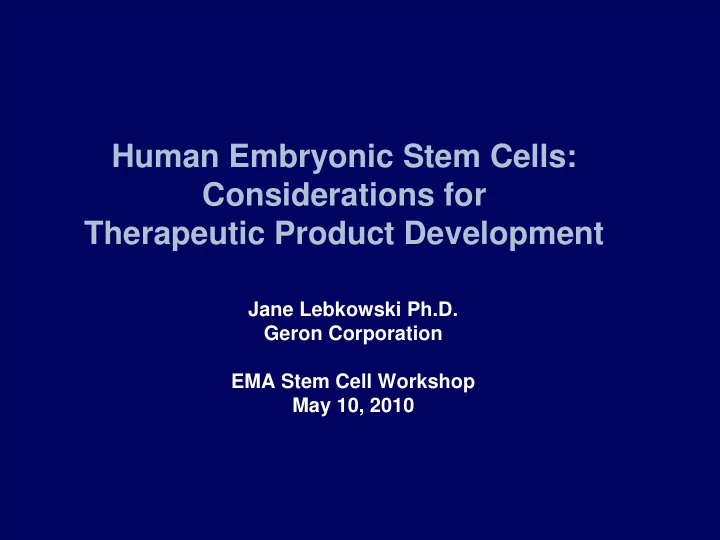

Human Embryonic Stem Cells: Considerations for Therapeutic Product Development Jane Lebkowski Ph.D. Geron Corporation EMA Stem Cell Workshop May 10, 2010
Human Embryonic Stem Cells Large Characterized cGMP Banks Human Embryonic Stem Cells Hepatocytes Blastocyst Chondrocytes Osteoblasts Drug Discovery Dendritic Cells Liver Failure Islets Arthritis Cardiomyocytes Osteoporosis Neural Cells And Bone Tolerance Induction Fractures Cancer Immunotherapy Diabetes Therapeutic Cells Heart Failure Spinal Cord Injury
hESC-Based Cell Therapy Distribution Scheme Central Manufacturing Facility Frozen Hospital Final Product hESC Formulation for Differentiation Starting Transplantation Material
Production Process for hESC Therapeutics hESC hESC Cell hESC Harvest, Vialing Cell Banks Expansion Differentiation and (Starting Material) Cryopreservation
Critical Technology Enabling Therapeutic Development of hESC Products Culture & Differentiation Clinical Scalable cGMP Development Production Delivery Cryopreserved Formulations Preclinical Preclinical Safety Efficacy
Qualification of hESC Lines for Cell Therapy Production No Evidence Of: � Mycoplasma � HIV 1 &2 � History Files � HTLV I/II � CMV � Adventitious Agents � HBV or HCV � Karotype � HHV-6 � Phenotype � EBV � Parvovirus B-19 � Performance � Mouse Adventitious Agents � Porcine Adventitious Agents � Rabbit Adventitious Agents � Eco-, Xeno- or Amphotropic Retroviruses � Adventitious Agents Detected In Vitro & In Vivo PTC Assays
hESC Cell Therapy Production Process Example for GRNOPC1 Requires Rigorous Detailed Development of Production Process Considerations/Challenges • Characterization of Materials • Starting Material • Reagent Performance • Characterization of Unit Operations • Cell Density • Culture Format • Scale • Timing of Induction • Stability of Storage Conditions
Characterization of hESC-Based Therapeutics Example for GRNOPC1 Attributes • Identity Lineage Marker • Purity Neural Progenitors Nestin • Strength Oligodendroglial Progenitors Olig 1 • Potency Oligodendroglial Progenitors NG2 Oligodendroglial Progenitors PDGFRa Early Ectoderm Pax 6 Challenges Early Ectoderm Sox 10 • Multiple Markers Required β TubIII Neurons • Lineage Specific Markers Astrocytes GFAP HNF3 β • Marker Specificity Early Endoderm Endoderm AFP • Antibody Specificity Early Mesoderm GATA4 • Detection and Quantitation Mesoderm MSA Limits of Assays Undifferentiated hESCs OCT4 • Potency Assays Undifferentiated hESCs Tra-1-60
Considerations for Nonclinical Studies for hESC-Based Therapeutics Final Product: • What is the Product Designed to Do? • What is the Target Site for Activity? Formulation: • Cryopreserved Format? • Selective Cell Survival? • Cellular Debris? Clinical Administration: • Site of Administration? • Dose Required? • Effects on Performance and Potential Adverse Events? • Need for Immunosuppression?
Activity & Efficacy of the hESC-Based Therapies 9 mos GRNOPC1 Considerations/Challenges hNuc In Vitro Activity EC • Protein and Gene Expression • Factor Production 1mm • Structural/ Metabolic Activity In Vivo Activity • Delivery Site and Method 100 μ m • Cell Survival 9 mos vehicle • Immune Responses hNuc • Phenotype Over Time EC • Proliferative Capacity • Clinical Efficacy 1mm • Histological Efficacy • Dose Requirements • Human Equivalent Dose • Timing of Treatment 100 μ m
Biodistributuion: Where Do The Cells Go? Example for GRNOPC1 Safety and Efficacy Implications • Not Detected Outside of CNS • Site for Intended Activity • Not Detected in the Brain • Sufficient Cells at Site • Greatest Concentration at the Injection, • Distribution Outside Target Site Injury Site • Migration at Local Site • Migrates Up to 5 cm from the Injury Site • Migration Not Dependent on Dose • Over Extended Time • Migration Dependent on Time • QPCR & Histological Methods • No Evidence of Migration Beyond 9 Mos
Toxicology Studies Example GRNOPC1 • Toxicity of Delivery Toxicity of Delivery Considerations/Challenges • Animal Survival • Doses of Product • Clinical Observations • Tox Model • Systemic Toxicity • Feasibility of Model • Hematological • Duration of Studies • Coagulation Parameters • Duration of Human • Clinical Chemistries Cell Survival • Macropathology • Micropathology • Allodynia
Tumorigenicity Studies Challenges • Human Dose • Long-Term Cell Survival • Large Numbers of Animals • Teratomas • Mimic Human Setting • Ectopic Tissues • Large Animals? • Local Injection Site • Homologous ESC Systems? • Distal Sites Considerations • Location of Ectopic Tissue • Clinical Consequences • Treatment Strategies
Tumorigenicity Studies GRNOPC1 Deliberately Spiked with hESCs Important Factors In Teratoma Formation • hESCs Cell Number • Site of Implantation • Cell Aggregation State 2 x 10 6 Cells Intraspinal Cord Injection Assessment 12 mos.
Allogenicity Studies • Immunosuppression Required? • Duration of Immunosuppression? Challenges No Excellent Solutions • Allogenicity In Vitro • hESC-Based Products are Xenografts • Utilize in All Animal Models Immunosuppression • Allogenicity of Maturing Cells In Vivo Regimens Compatible • Humanized Models with Human Clinical Indication • Tracking of Surviving Cells in Clinical Trial Subjects • Monitor Outcomes
Design of Clinical Trials Key Consideration: Patient Safety & Risk Mitigation Multidisciplinary Team of Physicians, Ethicists, Regulatory Bodies, Patients Advocates, etc to Develop Clinical Protocol Based on Potential Risks and Benefits of the Therapy Risk Mitigation • Protocol • Frequent & Long-term • Delivery Monitoring for Ectopic • Logistics of Trial Tissue/Masses • Minimize Potential Risks • Real-time Review of • Define Adverse Events Adverse Events • Monitor for Adverse Events • Independent DMC • Monitor Cell Survival • Follow-up of AEs • Assess Outcome Measures • Suspension Rules • Short & Long-Term Follow-up • Treatment Strategies if AEs Related to Product Occur
Conclusions • Numerous Considerations in Developing Cell Therapies • Some Challenges Common To All Cell Therapies • Some Challenges More Specific to hESC-Based Therapies • Some Challenges Vary in Importance Depending on Clinical Indication • Specific Nonclinical Study Designs Based on Clinical Considerations • Clinical Trial Designs Require Interdisciplinary Input • Risk Mitigation Strategy Required
Recommend
More recommend